





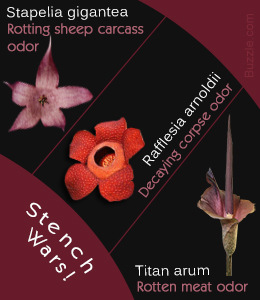 Unique Way to Spread the Whiff!Dead horse arum lily (that gives out the odor of decaying dead horse carcass) won't open up if the climate is dark and gloomy. It will wait till it is warm and sunny to spread the stench far and wide!In the evolution cycle, some flowers have developed such bizarre scents that their pollinators are not the usual 'attracted-to-sweet-smells' type. Carrion-scented flowers follow the principle of emitting a foul smell to attract scavenging flies, bugs, and predatory beetles for gathering and dispersing pollen. These insects are the ones, who lay their eggs on decaying and rotting things.A Few Facts
Unique Way to Spread the Whiff!Dead horse arum lily (that gives out the odor of decaying dead horse carcass) won't open up if the climate is dark and gloomy. It will wait till it is warm and sunny to spread the stench far and wide!In the evolution cycle, some flowers have developed such bizarre scents that their pollinators are not the usual 'attracted-to-sweet-smells' type. Carrion-scented flowers follow the principle of emitting a foul smell to attract scavenging flies, bugs, and predatory beetles for gathering and dispersing pollen. These insects are the ones, who lay their eggs on decaying and rotting things.A Few Facts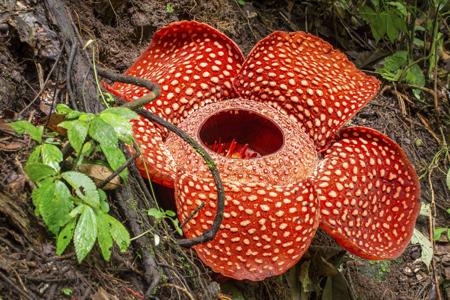 ► Rightly called the "giant panda of the plant world," corpse lily -- as it is commonly referred to -- is the largest individual flower in the world. It is found in the rainforests of Sumatra. This plant does not have leaves and stems.► It generally grows inside its host, which is a vine called Tetrastigma. The bud looks like an orange cabbage, and it breaks out through the woody stem to blossom into a flower that can spread up to 3 feet in diameter and weigh up to 11 kilos.► With five fleshy sepals that have raised white spots, this intriguing flower emits a stench, which is similar to a decaying corpse. It attracts bugs, beetles, and flies that carry pollen from male to female flowers.► It is considered as an endangered species because it is unisexual and requires cross-pollination. It is very rare that a female flower will bloom at the same time as the male. When the flower gets pollinated, it will leave a fruit that will attract squirrels and other ground animals. They will snack on the fruit, and in turn, scatter the seeds.Amorphophallus titanum
► Rightly called the "giant panda of the plant world," corpse lily -- as it is commonly referred to -- is the largest individual flower in the world. It is found in the rainforests of Sumatra. This plant does not have leaves and stems.► It generally grows inside its host, which is a vine called Tetrastigma. The bud looks like an orange cabbage, and it breaks out through the woody stem to blossom into a flower that can spread up to 3 feet in diameter and weigh up to 11 kilos.► With five fleshy sepals that have raised white spots, this intriguing flower emits a stench, which is similar to a decaying corpse. It attracts bugs, beetles, and flies that carry pollen from male to female flowers.► It is considered as an endangered species because it is unisexual and requires cross-pollination. It is very rare that a female flower will bloom at the same time as the male. When the flower gets pollinated, it will leave a fruit that will attract squirrels and other ground animals. They will snack on the fruit, and in turn, scatter the seeds.Amorphophallus titanum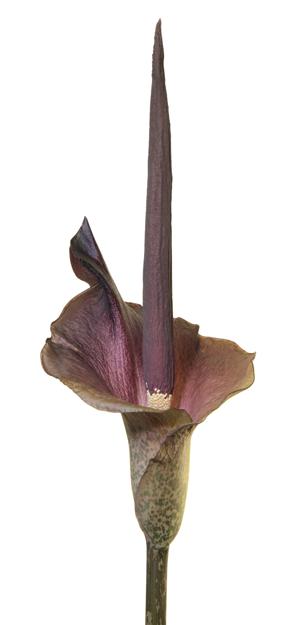 ► Also called the titan arum, devil's tongue, corpse flower, and snake palm, it is a native of the equatorial rainforests of Sumatra.► It has an erect flower-bearing spadix in the center that is over 8-feet tall and grows from a pleated spathe that can be over 4-feet tall and around 12-feet in circumference.► The tuber from which this flower develops can be around 6 feet in circumference and can weigh up to 46 kilos.► This flower may seem as an individual flower, but it is not. Instead it's an inflorescence of several hundred male and female flowers that are located at the base of the spadix.► Male flowers are located above the female flowers. They mature at different times with female flowers becoming active before the male flowers release pollen. This flower has a rotting meat smell that can be detected up to half a mile.► These flowers are not regular bloomers -- they open up very rarely. Titan arum blooms once or twice in a decade. Usually, nurseries and other plant care centers take up the job of pollinating these plants manually, thus saving the species from getting extinct.► When these flowers bloom, they attract a large crowd of spectators, who are willing to take a sniff of this virtual corpse.Bulbophyllum phalaenopsis
► Also called the titan arum, devil's tongue, corpse flower, and snake palm, it is a native of the equatorial rainforests of Sumatra.► It has an erect flower-bearing spadix in the center that is over 8-feet tall and grows from a pleated spathe that can be over 4-feet tall and around 12-feet in circumference.► The tuber from which this flower develops can be around 6 feet in circumference and can weigh up to 46 kilos.► This flower may seem as an individual flower, but it is not. Instead it's an inflorescence of several hundred male and female flowers that are located at the base of the spadix.► Male flowers are located above the female flowers. They mature at different times with female flowers becoming active before the male flowers release pollen. This flower has a rotting meat smell that can be detected up to half a mile.► These flowers are not regular bloomers -- they open up very rarely. Titan arum blooms once or twice in a decade. Usually, nurseries and other plant care centers take up the job of pollinating these plants manually, thus saving the species from getting extinct.► When these flowers bloom, they attract a large crowd of spectators, who are willing to take a sniff of this virtual corpse.Bulbophyllum phalaenopsis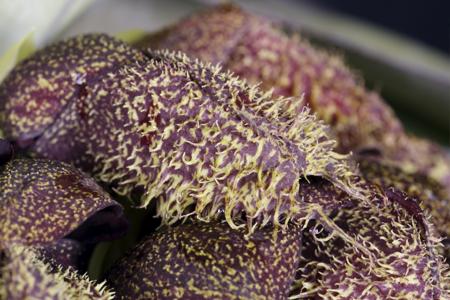 ► This plant belongs to the largest genus of orchids, Bulbophyllum.► However, it doesn't stand true to the family. It belongs to the category because orchids are a family of flowers that produce exquisite fragrances and some intricate blooms.► This plant does not look as bad as it smells; one can say that it stinks really bad, as it produces a carrion smell like that of dead, decaying mice. It is mainly for attracting the plant's natural pollinators -- flies.► The leaves are very large and can extend up to 4 feet. The flowers have a red leathery appearance with shiny spikes that mimics rotten meat odor.Stapelia gigantea
► This plant belongs to the largest genus of orchids, Bulbophyllum.► However, it doesn't stand true to the family. It belongs to the category because orchids are a family of flowers that produce exquisite fragrances and some intricate blooms.► This plant does not look as bad as it smells; one can say that it stinks really bad, as it produces a carrion smell like that of dead, decaying mice. It is mainly for attracting the plant's natural pollinators -- flies.► The leaves are very large and can extend up to 4 feet. The flowers have a red leathery appearance with shiny spikes that mimics rotten meat odor.Stapelia gigantea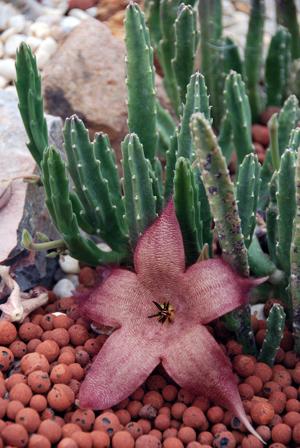 ► It's got the looks! However, don't be fascinated by its star-shaped beautiful bloom, because the stink is equally noxious to drive you away.► The texture of the flower is such that is mimics the flesh of a dead, rotting sheep carcass. This quality along with the foul odor is what attracts the flies and beetles to this flower.► The flies are so deceived by the smell that they lay their eggs in the hope that it will feed the hatching larvae. But the little maggot would soon die, because it won't get any nourishment from this flower. It is just a trick that the plant uses for pollination.► Some species of the genus Stapelia (like Stapelia hirsuta) are such that they look like red, rotting flesh, and this look is enough to deceive the eyes of flies.► Due to its aesthetic appeal, this flower enjoys quite a buzz with the gardeners, but it's quite obvious that these stars are strictly meant for outdoor purposes.Symplocarpus foetidus
► It's got the looks! However, don't be fascinated by its star-shaped beautiful bloom, because the stink is equally noxious to drive you away.► The texture of the flower is such that is mimics the flesh of a dead, rotting sheep carcass. This quality along with the foul odor is what attracts the flies and beetles to this flower.► The flies are so deceived by the smell that they lay their eggs in the hope that it will feed the hatching larvae. But the little maggot would soon die, because it won't get any nourishment from this flower. It is just a trick that the plant uses for pollination.► Some species of the genus Stapelia (like Stapelia hirsuta) are such that they look like red, rotting flesh, and this look is enough to deceive the eyes of flies.► Due to its aesthetic appeal, this flower enjoys quite a buzz with the gardeners, but it's quite obvious that these stars are strictly meant for outdoor purposes.Symplocarpus foetidus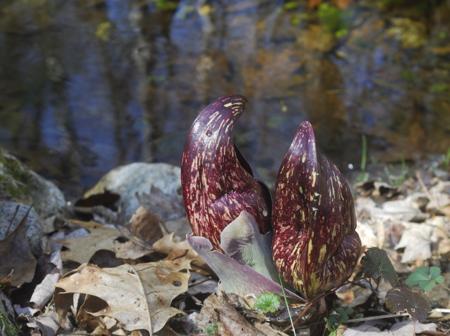 ► Also called skunk cabbage, these plants grow in wetlands. The broad leaves and mottled brown color make this flower quite a spectacle to look at.► But tear open a leaf and you will experience the most fetid odor, like that of a roadkill skunk, which can only attract blowflies and dung beetles.► Another striking feature of this plant is that it exhibits thermogenesis. It can raise its internal temperature up to 35° C. This property helps the plant to survive the harsh winter conditions.► It easily melts its way through the snow and starts blooming while other plants are still hibernating.► This plant becomes a temporary shelter for the insects, which are trying to seek solace from the freezing weather. The benefit becomes mutual, because the plant provides shelter, and the insect, in turn, deposits the pollen on its stigma and also disperses its stench.Hydnora africana► With no leaves and traces of chlorophyll, this brown-gray parasite usually grows on the roots of the species of the genus Euphorbia. It is found in areas of arid and sub-arid vegetation.► It has orange-red-colored flesh on the interior and a leather-like outer covering. The buds develop underground and start emerging after which the plant attains a height of about 100 to 150 mm.► The lobes are fused initially, and as the plant matures, they start rupturing vertically.► The bait bodies start emitting putrid odor, like that of feces that attracts herds of beetles, flies, and other insects. The insects feed on the bait bodies, after which they fall into the flower tube.► In this tube, they get completely covered by pollen. They then fall further down onto the female stigma, thus pollinating the flower. It is not a cultivated plant due to its dependency on the host.Helicodiceros muscivorus► Also known as dead horse arum lily, this plant emits a stench, which is similar to that of a decaying dead horse, or a sheep carcass.► It has an intelligent fly trap. As the fly gets lured by the smell, it forces its way along the spadix and goes right inside the dark chamber through the funnel-shaped spathe.► After reaching the bottom of the chamber, it pollinates the female stigma with the pollen on its body.► However, the fly is not able to come out due to the thick bunch of stiff hair that faces downwards. It has to remain as a prisoner until the bunch of male flowers above the hair release pollen.► As soon as the pollen is released and the fly gets dusted with it, the barrier of stiff hair wilts and the fly is free to escape the dark and damp foul-smelling chamber.Dracunculus vulgaris
► Also called skunk cabbage, these plants grow in wetlands. The broad leaves and mottled brown color make this flower quite a spectacle to look at.► But tear open a leaf and you will experience the most fetid odor, like that of a roadkill skunk, which can only attract blowflies and dung beetles.► Another striking feature of this plant is that it exhibits thermogenesis. It can raise its internal temperature up to 35° C. This property helps the plant to survive the harsh winter conditions.► It easily melts its way through the snow and starts blooming while other plants are still hibernating.► This plant becomes a temporary shelter for the insects, which are trying to seek solace from the freezing weather. The benefit becomes mutual, because the plant provides shelter, and the insect, in turn, deposits the pollen on its stigma and also disperses its stench.Hydnora africana► With no leaves and traces of chlorophyll, this brown-gray parasite usually grows on the roots of the species of the genus Euphorbia. It is found in areas of arid and sub-arid vegetation.► It has orange-red-colored flesh on the interior and a leather-like outer covering. The buds develop underground and start emerging after which the plant attains a height of about 100 to 150 mm.► The lobes are fused initially, and as the plant matures, they start rupturing vertically.► The bait bodies start emitting putrid odor, like that of feces that attracts herds of beetles, flies, and other insects. The insects feed on the bait bodies, after which they fall into the flower tube.► In this tube, they get completely covered by pollen. They then fall further down onto the female stigma, thus pollinating the flower. It is not a cultivated plant due to its dependency on the host.Helicodiceros muscivorus► Also known as dead horse arum lily, this plant emits a stench, which is similar to that of a decaying dead horse, or a sheep carcass.► It has an intelligent fly trap. As the fly gets lured by the smell, it forces its way along the spadix and goes right inside the dark chamber through the funnel-shaped spathe.► After reaching the bottom of the chamber, it pollinates the female stigma with the pollen on its body.► However, the fly is not able to come out due to the thick bunch of stiff hair that faces downwards. It has to remain as a prisoner until the bunch of male flowers above the hair release pollen.► As soon as the pollen is released and the fly gets dusted with it, the barrier of stiff hair wilts and the fly is free to escape the dark and damp foul-smelling chamber.Dracunculus vulgaris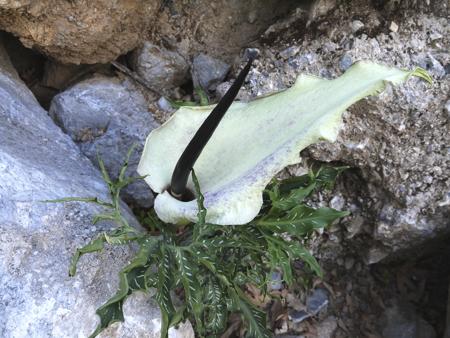 ► Also known as voodoo lily, stinky lily, black lily, viagra lily, dragonwort, and drakondia, this flower is quite pretty to look at. It has a single blackish-purple-colored spathe that can reach a length of 125 cm and a single spadix that can cross 135 cm in height.► Its name is inspired by the look of the spathe and the spadix that looks like the tongue of a fire-breathing dragon.► Similar to other carrion plants, this one also emits a rotten meat smell when it is ready for pollination to attract flies and bugs.► Similar to other carrion plants, this one also emits a rotten meat smell when it is ready for pollination to attract flies and bugs.► This plant has another unique benefit -- it is believed that if one carries its roots or leaves, vipers and snakes can be kept off with impunity.Whatever be the smell -- carrion, corpse, or morbid, these plants successfully fool the flies with their sinless smell of death.
► Also known as voodoo lily, stinky lily, black lily, viagra lily, dragonwort, and drakondia, this flower is quite pretty to look at. It has a single blackish-purple-colored spathe that can reach a length of 125 cm and a single spadix that can cross 135 cm in height.► Its name is inspired by the look of the spathe and the spadix that looks like the tongue of a fire-breathing dragon.► Similar to other carrion plants, this one also emits a rotten meat smell when it is ready for pollination to attract flies and bugs.► Similar to other carrion plants, this one also emits a rotten meat smell when it is ready for pollination to attract flies and bugs.► This plant has another unique benefit -- it is believed that if one carries its roots or leaves, vipers and snakes can be kept off with impunity.Whatever be the smell -- carrion, corpse, or morbid, these plants successfully fool the flies with their sinless smell of death.
Copyright © www.100flowers.win Botanic Garden All Rights Reserved